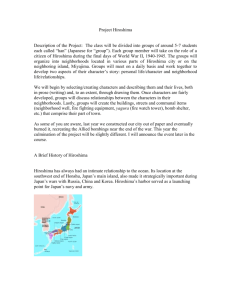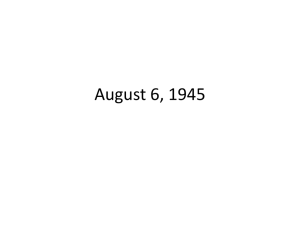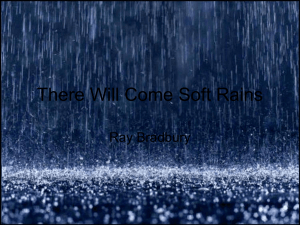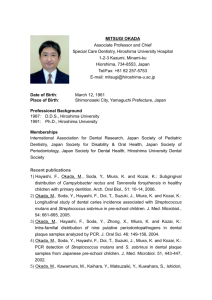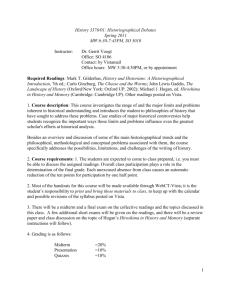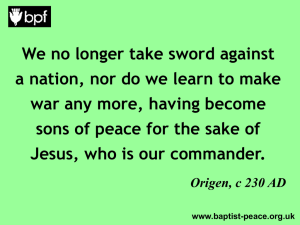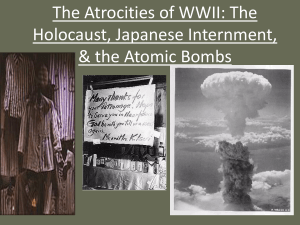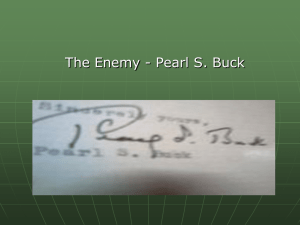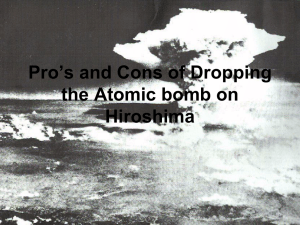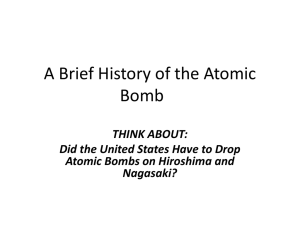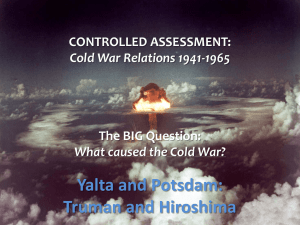Hiroshima PowerPoint
advertisement
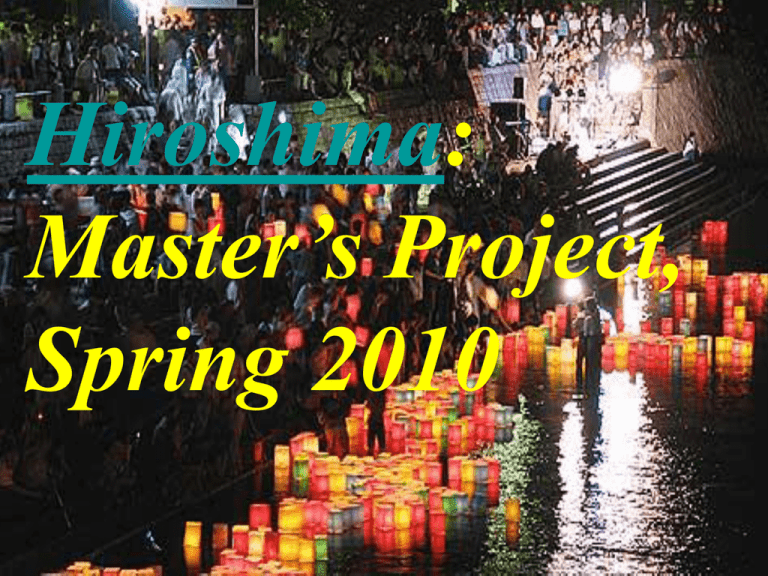
Hiroshima: Master’s Project, Spring 2010 Kazuo Matsumuro was 32 when she witnessed the Hiroshima bombing 1300 meters from the epicenter. She said that people's skin was falling off and they kept their arms in front of them like zombies to prevent the skin from sticking. “There were the shadowy forms of people, some of whom looked like walking ghosts. Others moved as though in pain, the scarecrows, their arms held out from their bodies with forearms and hands dangling. These people puzzled me until I suddenly realized that they had been burned and were holding their arms out to prevent the painful friction of raw surfaces rubbing together.” Photos the U.S.Government and Military Wanted the Public to See Hibakusha: Bomb Affected People Hibakusha Testimonies: Gives a Face to the Tragedy of the A-Bombings. Produced by the Hiroshima Peace Culture Foundation. Takakura, Hibakusha Age 20 Numata, Age 22 Kang, Age 26 Excerpt from Hiroshima Reflection Paper As an educator writing an historical feature film, I was and I am aware that a movie has the power to shape how students and citizens think about the past. Excerpt from Hiroshima Reflection Paper As Robert Rosenstone has observed: “It must be clear to even the most academic of historians that the visual media have become (perhaps) the chief conveyor of public history, that for every person who reads a book on an historical topic which a film has been made … many millions of people are likely to encounter that same past on the screen.” Excerpt from Hiroshima Reflection Paper Without sufficient background knowledge and critical viewing skills, “a possible (or probable) outcome is for the filmic account to ‘colonize’ their [students’] thinking about the past – taking up residence in the mind as a kind of literal truth” (VanSledright, 2002). Logline: A Japanese-American spy smuggled into Hiroshima, Japan in 1945 falls in love with a young, wealthy Japanese woman jeopardizing his mission and his life. Their love leads to a chain reaction of events and the decision to drop the first atomic bomb on Hiroshima. RINGS OF TEARS Focus Group Questions How do you feel about the Hiroshima screenplay and project? What went through your head as you read and/or reviewed Hiroshima? What struck you most about Hiroshima? (positive or negative) What did you learn by reading and/or reviewing Hiroshima? In your view, did Hiroshima succumb or avoid Presentism? Do you have any additional thoughts or insights? Presentism is “the act of viewing the past through the lens of the present.” Summary of Focus Group Findings Hiroshima was authentic, well written and avoided presentism. One or two plot points and three or four uses of dialogue could improve the story even more. The group agreed that Hiroshima be marketed to independent producers in order to retain the spirit of the project. Further Reflections What would be a Japanese audience’s reaction to Hiroshima? The Participants gained new historical knowledge and insights into the dropping of the ABomb. One Participant was very disturbed by the torture scenes which prompted me to review their necessity to the story. The Participants did not bring up the issue of English subtitling used when the characters speak in Japanese. Future Focus Group Questions What three new historical facts did you learn by reading the screenplay? Whom does the movie want the audience to cheer for or against? What perspectives on the past does the movie encourage the audience to empathize with and why? What moral reactions about the past does the movie aim to evoke, or provoke, in viewers? Why is Hiroshima telling a story in a particular way? Hiroshima begins and Ends with the lanterns honoring those who died August 6, 1945 EXT. POND HIROSHIMA, JAPAN - NIGHT Hundreds of red, orange and yellow paper lanterns, lit by single candles, float and bob in a well kept pond. Japanese elders in their eighties and nineties, some with burn scares on their wrinkled faces and some with severe limps, hobble with their families beside the pond. Children playfully launch paper lanterns. The sound of a running stream drowns out the gleeful cries of children. SETSU struggles to write on a piece of rice paper. Her hands have a strong dose of arthritis. Her twenty-one year old grandson, YOUNG SADAO, walks by her side. His outfit typifies current Japanese pop culture. He holds a red paper lantern. Setsu hands paper and pen to young Sadao. He positions the lantern on the ponds bank. SETSU Please write Sadao Finn. YOUNG SADAO Finn? Sadao writes Sadao Finn on the rice paper. Setsu sprinkles a few white chrysanthemum petals inside the lantern. Young Sadao squats down, lights the candle with a butane lighter and with honor and respect launches the lantern into the pond. The current carries it away. Setsu’s family follows the lantern. Setsu and young Sadao hang back. SETSU Out of respect for your grandfather I never told the true story. Now that he has passed away and the times are more forgiving, I can share it. (pause) It was dawn at our mountain home ... My Website The End Thank You!
